

Our Game Lures
We are not yet marketing the patented lures, preferring to further perfect them. They are quite effective, so a question of
fair hunting ethics arises. Also, one of the lures uses an active light, and active lighting is illegal in many states. The active
illumination lure was primarily developed to be used by authorities for attracting and culling deer when they reach pest
concentrations.
The photographs illustrate the attraction of deer to the fractal
geometric shape (yellow color spot) and specific wavelength
animal color recognition radiance, and the radiation lure (seen
by camera as bright blue). The colors are not truly
representative of the radiation wavelengths as deer and elk
see them; film and digital cameras are designed to show
colors as humans see colors.
I have researched a new type of big game animal lure in the
past twenty years. It is based on a new form of geometry,
animal curiosity and behavior, and on the way animals
perceive their world. Most current lures focus on the sexual attractants of estrus urine or realistic illustrations of animals
(decoys). My lure largely ignores these human interpretations of what animals should respond to. Instead, I focus on how
an animal recognizes what is out of context with their surroundings, but appears "somehow familiar" enough to their
vision capabilities to be curiously interesting.
It is not the attractiveness of a lure that humans that counts, but
what the animals are able to see and perceive as an attractant.
The lure is mathematically calculated to fit a particular species in
terms of a relatively new geometry called Fractal Geometry.
International Business Machines hired the mathematician Benoit
Mandlebrot to devise a new way to look at natural objects, actions,
and processes. Mandlebrot tried to define the coastline of England
in typical Euclidian geometry. This uses lines, circles, triangles,
boxes, radian angles and dimensions to describe an object. It best
constructs what we humans see, but it is actually just an
approximation in human values of what is really there.
Mandelbrot's coastline studies produced a profound conclusion. No
matter at what scale you looked at the coastline, the view had the
same shape. Look at the coast from space, from an airplane, from a
cliff, or while walking on the beach, and the outline has the same
basic attributes. What Mandelbrot recognized was that it was not the
object that needed to be defined, but the process that created the
object. Wave action created the coastlines, and the coastlines
represent the erosional processes working on the specific type of
rocks.
Popular fractal geometry appeared in artwork and as T-shirt designs.
The designs were created by simple mathematical formulas that were done over and over again at different scales.
These repetitive calculations are called iterations. Now fractal use has permeated our daily lives. Remember the
cumbersome, large radio antennas that were strung from poles, and later car radio antennas, and then backpack sized
satellite antennas? Now you have a satellite receiver antenna in a wrist watch or digital camera. Scientists found that the
angularity of an antenna was its basis for capturing electromagnetic waves. Programing a computer to make successively
smaller triangles on a computer chip results in a stupendously efficient antenna for low energy radio wave
concentration.
Mandelbrot then realized that iterations in nature produced the natural object. For example, consider a seedling sprout
emerging from the soil. It responds to nutrients, warmth and sunlight. As it grows, its genetic code begins to reiterate. A
side sprout shoots off. In the proper time it and the main stem again send off side shoots. These become branches, to
be iterated into leaves, and eventually a tree. Each tree has its own genetic code. Its shape, branches, bark, leaf shape,
and leaf color are the result of the genetic-driven process of formation. While each tree in an oak grove may be slightly
different, they have a shape of process - which is the fractal dimension of all oak trees of a given oak species.
Now lets consider how we know one group of trees is oak, another maple and a third
ponderosa pine. Do we demand to get closer to the trees, or even feel or climb them?
Do we mentally get out our Euclidian geometry and analyze each grove to arrive at a
conclusion? No, we just intuitively know what is right for separating the tree species. We
are using our natural cognitive ability to recognize each tree's fractal dimension without
knowing we are doing so. We know what is similar to an object(s), independent of scale
(closeness). That is what animals do. Moreover, in my opinion animals instantly
recognize what is not in fractal geometrical balance; in other words something that is
out of "harmony". In my book I stress the goal of becoming so familiar with the hunt
area that you unconsciously are alerted to out of balance clues. This is what I term the
Proximity Factor. You just know game is present.
Motion also has a fractal dimension. That is because motion is is created by interaction
of ALL the geometrical elements of the moving object. For example, all bones and muscles of a particular living being.
Let's assume you are hunting and see several identically shaped, sized and clothed hunters walking along 500 yards
away. Just about five seconds after you see the group you gasp - the third one is a woman! Without thinking you
analyzed and evaluated the situation to conclude one is a woman. What actually happened is that you recognized
woman are anatomically build differently and therefore move differently. More to the point, women have a wider pelvis
for giving birth, and breasts which affect upper torso movement. Your past experience seeing women move
subconsciously recognized the movement similarity. Our elk lure incorporates this species-specific movement similarity.
This movement similarity can be mimiced and used when hunting elk. For exapmle, some Indians learned to dismount
their horse and nudge it toward grazing elk. The Indian would walk beside the horse and imitate the slow leg, arm and
head and track movements of his grazing horse. Coercing his horse gently in the direction of elk, the Indian could get
close enough for a bow or even spear shot. Now consider how you might stalk on foot or horse mount. Is it slow and
consistent with the movements of the surroundings through which you are traveling? (I give a lot of hunt savvy to Indians
in my book, and stress that a hunter must know the animals well to be the most successful.)r
I've gone deep enough into fractal geometry to explain my lure. I have measured deer and elk to determine their fractal
dimension. This calculated value was used to create an object that just looks terribly familiar to elk and deer, but still odd
enough to attract their curiosity. "If it is not an elk, then what is it?", they might think.
Let me give you a human hunting example for comparison. It is falling light and you are looking toward a field of stumps.
You scan for elk. One stump catches your attention. You squint, patiently watch for movement, and wait. Of all the many
stumps, your subconscious mind tells you this looks like an elk. The many traits of this stump combined together makes
it a prime suspect. It fits your subconscious idea of what an elk looks like.
The lures also incorporate light wavelengths that ungulates are able to see. These colors (many not visible to humans)
are used in spectral concentrations which are exciting to the game species. A reverse example is the fluorescent hunting
vest. Humans instantly vision instantly fixates on the safety vest orange fluorescent color, because the color is not
natural. Yet game only see brightness against a dark background of trees. In the same way, animals see the lures.
(Left) Five cow elk approach the lure in early morning, stare
at it for a while, and then retreat back into the trees.
(
(Above) Cow elk approach the lure, stand, mill, retreat, and
then go to the right. A bull approached the lure later,
stopped to stare at it, and soon filled our freezer.
Note: Our patented lures are completing development,
but are not available yet for purchase.
.
Our summer “research laboratory”. Stop by and say hello if you see it.
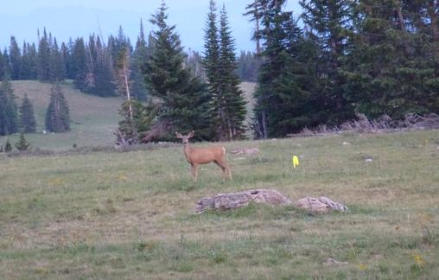
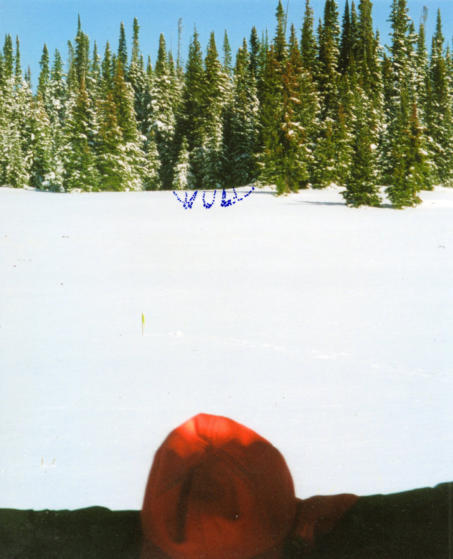
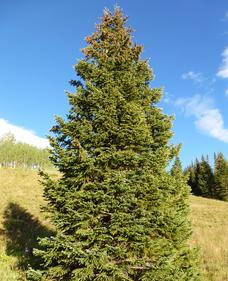
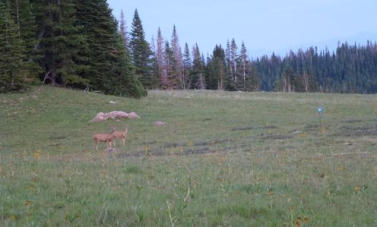
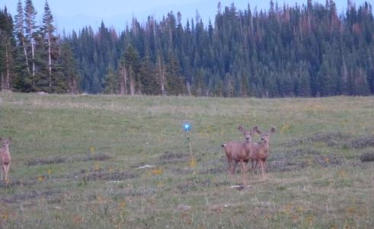


Lure

© 2014-2021 Copyright by P. K. H. Groth, Denver, Colorado, USA All rights reserved - See contact page for for permission to republish article
excerpts.




- Hunter welfare
- Hunter poster child
- Altitude sickness
- Hunter heart attacks
- Hunter heart stress
- Altitude sleep problems
- Hunter spine/bone damage
- Back country hazards
- Man made hazards
- Hunter bear attacks
- Bear problems
- Mtn lion Awareness
- Insect problems and diseases
- Hunt camp rodent problems
- Game meat dangers
- Elk meat diseases


Our Game Lures
We are not yet marketing the patented lures, preferring to
further perfect them. They are quite effective, so a
question of fair hunting ethics arises. Also, one of the lures
uses an active light, and active lighting is illegal in many
states. The active illumination lure was primarily developed
to be used by authorities for attracting and culling deer
when they reach pest concentrations.
The photographs illustrate the attraction of deer to the
fractal geometric shape (yellow color spot) and specific
wavelength animal color recognition radiance, and the
radiation lure (seen by camera as bright blue). The colors
are not truly representative of the radiation wavelengths as
deer and elk see them; film and digital cameras are
designed to show colors as humans see colors.
I have researched a new type of big game animal lure in
the past twenty years. It is based on a new form of
geometry, animal curiosity and behavior, and on the way
animals perceive their world. Most current lures focus on
the sexual attractants of estrus urine or realistic
illustrations of animals (decoys). My lure largely ignores
these human interpretations of what animals should
respond to. Instead, I focus on how an animal recognizes
what is out of context with their surroundings, but appears
"somehow familiar" enough to their vision capabilities to
be curiously interesting.
It is not the attractiveness of a lure that humans that
counts, but
what the
animals
are able to
see and
perceive as
an
attractant.
The lure is
mathematically calculated to fit a particular species in
terms of a relatively new geometry called Fractal Geometry.
International Business Machines hired the mathematician
Benoit Mandlebrot to devise a new way to look at natural
objects, actions, and processes. Mandlebrot tried to define
the coastline of England in typical Euclidian geometry. This
uses lines, circles, triangles, boxes, radian angles and
dimensions to describe an object. It best constructs what
we humans see, but it is actually just an approximation in
human values of what is really there.
Mandelbrot's coastline studies produced a profound
conclusion. No matter at what scale you looked at the
coastline, the view had the same shape. Look at the coast
from space, from an airplane, from a cliff, or while walking
on the beach, and the outline has the same basic
attributes. What Mandelbrot recognized was that it was not
the object that needed to be defined, but the process that
created the object. Wave action created the coastlines, and
the coastlines represent the erosional processes working
on the specific type of rocks.
Popular fractal geometry appeared in artwork and as T-
shirt designs. The designs were created by simple
mathematical formulas that were done over and over
again at different scales. These repetitive calculations are
called iterations. Now fractal use has permeated our daily
lives. Remember the cumbersome, large radio antennas
that were strung from poles, and later car radio antennas,
and then backpack sized satellite antennas? Now you have
a satellite receiver antenna in a wrist watch or digital
camera. Scientists found that the angularity of an antenna
was its basis for capturing electromagnetic waves.
Programing a computer to make successively smaller
triangles on a computer chip results in a stupendously
efficient antenna for low energy radio wave concentration.
Mandelbrot then realized that iterations in nature
produced the natural object. For example, consider a
seedling sprout emerging from the soil. It responds to
nutrients, warmth and sunlight. As it grows, its genetic
code begins to reiterate. A side sprout shoots off. In the
proper time it and the main stem again send off side
shoots. These become branches, to be iterated into leaves,
and eventually a tree. Each tree has its own genetic code.
Its shape, branches, bark, leaf shape, and leaf color are the
result of the genetic-driven process of formation. While
each tree in an oak grove may be slightly different, they
have a shape of process - which is the fractal dimension of
all oak trees of a given oak species.
Now lets consider how we
know one group of trees is
oak, another maple and a third
ponderosa pine. Do we
demand to get closer to the
trees, or even feel or climb
them? Do we mentally get out
our Euclidian geometry and
analyze each grove to arrive at
a conclusion? No, we just
intuitively know what is right
for separating the tree species.
We are using our natural
cognitive ability to recognize
each tree's fractal dimension
without knowing we are doing so. We know what is similar
to an object(s), independent of scale (closeness). That is
what animals do. Moreover, in my opinion animals
instantly recognize what is not in fractal geometrical
balance; in other words something that is out of
"harmony". In my book I stress the goal of becoming so
familiar with the hunt area that you unconsciously are
alerted to out of balance clues. This is what I term the
Proximity Factor. You just know game is present.
Motion also has a fractal dimension. That is because
motion is is created by interaction of ALL the geometrical
elements of the moving object. For example, all bones and





© 2016 -2021 Copyright by P. K. H. Groth, Denver, Colorado, USA All rights reserved -
See contact page for for permission to republish article excerpts.


- Hunter welfare
- Hunter poster child
- Altitude sicknesses
- Hunter heart attack
- Hunter heart stress
- Altitude sleep problems
- Hunter spine and bone injuries
- Back country hazards
- Man caused hazards
- Bear attacks
- Bear camp problems
- Mountain. lion awareness
- Insect diseases and problems
- Camp rodent problems
- Game meat dangers
- Elk diseases

























